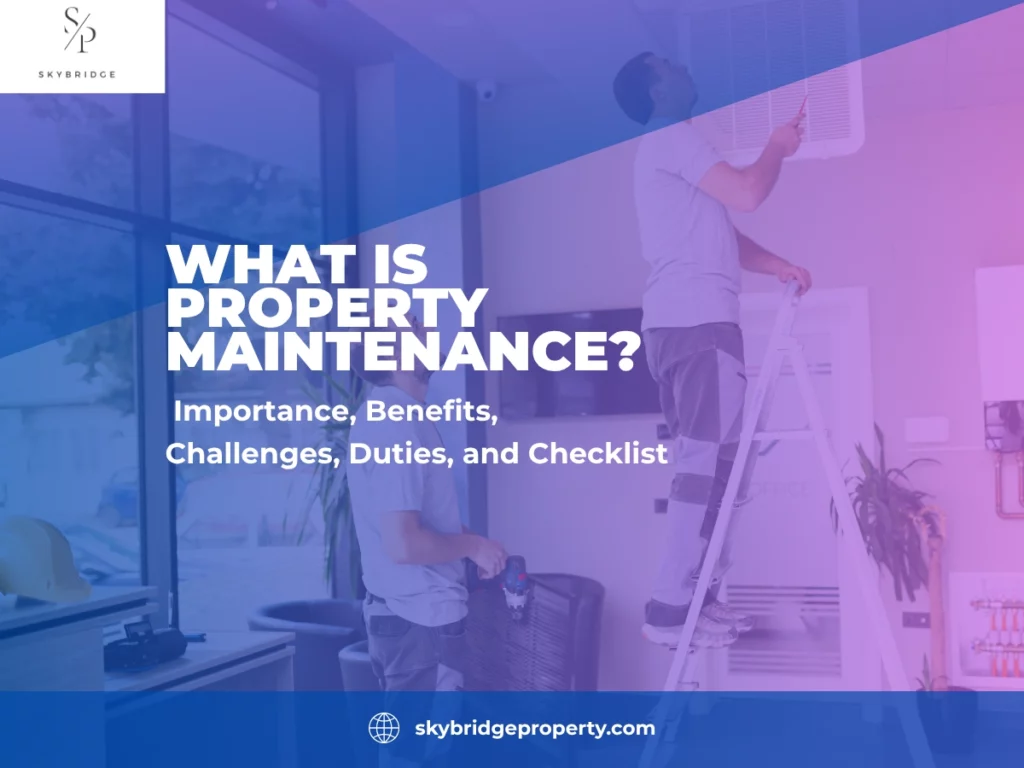Property maintenance is the ongoing process of ensuring a property’s safety, functionality, and value through regular inspections, timely repairs, and preventive upkeep. It includes a range of tasks such as plumbing checks, HVAC servicing, electrical inspections, structural repairs, and common area maintenance. The purpose is to prevent small issues from escalating and to ensure the property remains suitable for occupants and compliant with regulations.
The maintenance process operates through a structured cycle that begins with identifying potential issues, followed by scheduling and performing necessary tasks. Responsibilities are assigned to staff or service providers, and inspections are carried out routinely to assess condition and performance. Preventive actions are taken to minimize the risk of failure, while reactive tasks are used to fix problems that have already occurred. Maintenance logs and inspection reports help ensure that repairs are timely and that systems remain in working order.
When implemented effectively, this process improves property value, reduces safety hazards, and lowers the likelihood of emergency repairs. For example, preventive inspections can reduce unexpected repair costs by 30 to 40% while extending the lifespan of essential systems like heating, cooling, and water supply.Although maintenance involves challenges like cost and workforce availability, a proactive approach allows property owners to manage repairs efficiently.
Why is Property Maintenance Important?
Property maintenance is essential for sustaining a property’s financial value, structural integrity, and livability over time. It protects against deterioration, ensures systems function reliably, and creates a safe, comfortable environment for occupants. By minimizing the risk of major failures and supporting regulatory compliance, maintenance directly contributes to long-term cost control and tenant satisfaction.
Preservation of Property Value
Routine property maintenance preserves value by preventing gradual deterioration, addressing wear before it becomes visible damage, and ensuring systems like roofing, HVAC, and plumbing remain functional. These efforts reduce long-term damage and support better appraisal outcomes. Well-maintained properties typically retain 10 to 15% higher market value compared to neglected ones, attracting buyers who prioritize reduced risk and fewer expected repairs at the point of purchase or lease.
Enhancing Tenant Satisfaction
Regular maintenance enhances tenant satisfaction by ensuring comfort, safety, and prompt issue resolution. Tasks like timely HVAC servicing during seasonal transitions, quick fixes for plumbing issues, and keeping communal areas clean directly influence tenant retention. When tenants feel that property issues are addressed promptly, they are more likely to renew leases and refer others, resulting in lower turnover and greater occupancy consistency.
Preventing Costly Repairs
Preventive maintenance reduces the likelihood of costly repairs by catching small problems, such as minor leaks, cracks, or worn parts, before they escalate into major failures. For example, servicing an HVAC unit for $150 can prevent a breakdown that might cost over $2,500. By reducing emergency interventions, owners can maintain more predictable repair budgets and prevent financial setbacks caused by sudden equipment failures or tenant complaints.
Compliance with Safety and Health Standards
Ongoing maintenance ensures compliance with safety and health regulations by keeping critical systems, such as fire alarms, carbon monoxide detectors, and electrical panels, fully operational and routinely inspected. When these systems are neglected, the risk of penalties, legal claims, or tenant harm increases significantly. Consistent upkeep not only safeguards occupants but also simplifies regulatory audits by providing accurate maintenance records and proof of due diligence.
Improving Aesthetic Appeal
Consistent maintenance enhances a property’s appearance by preventing visible neglect and preserving key exterior features. Fresh paint, trimmed landscaping, and clean pathways reflect professionalism and attention to detail. These visual cues not only impress visitors and potential tenants but also increase the perceived quality of the property. Aesthetic appeal can directly influence rental rates, buyer interest, and time spent on the market.
Reducing Emergency Repairs
Scheduled inspections allow property owners to identify signs of failure in plumbing, electrical, or HVAC systems before they lead to major disruptions. By addressing these issues early, costly emergency service calls can be avoided and tenant inconvenience significantly reduced. As emergency repairs decrease, property operations become more predictable. This not only improves budgeting accuracy but also reduces management stress and strengthens tenant confidence through more reliable service delivery.
Increasing Operational Efficiency
Systems that are regularly maintained tend to consume less energy and operate with greater consistency. Maintenance tasks such as cleaning filters, tightening fittings, and adjusting thermostats ensure HVAC and plumbing systems run at optimal performance. As a result, energy usage drops, which can lower utility bills by up to 20%. This improved efficiency also minimizes wear, extending equipment lifespan and reducing downtime caused by system breakdowns or overloads.
Extending the Lifespan of Property Components
Routine care helps extend the functional life of critical components like roofing, piping, and electrical infrastructure. Simple actions, like clearing debris from gutters or inspecting plumbing for corrosion, prevent gradual damage from escalating. Over time, this reduces the need for premature replacements and large-scale renovations. Properties benefit not only from reduced capital expenditures but also from improved structural stability and long-term operational resilience.
Enhancing Property’s Marketability
Properties that are clean, functional, and well-maintained tend to generate stronger interest from prospective renters and buyers. The presence of modern appliances, intact finishes, and documented maintenance history signals reliability and lower move-in risk. These elements combine to shorten listing times and justify premium pricing. In competitive markets, a well-maintained unit is often rented or sold up to 25% faster than those requiring immediate repairs.
Lowering Insurance Costs
Well-maintained properties are seen as lower risk by insurance providers, which often results in reduced premiums and more favorable policy terms. Preventive efforts, such as inspecting wiring, sealing water entry points, and documenting upkeep, help limit claim frequency and demonstrate responsible ownership. As claim volume decreases, insurers may offer savings of 10 to 20% annually, improving financial predictability while ensuring continued access to comprehensive coverage options.
Estimated Property Value:
Estimated Maintenance Cost:
What Are the Core Components of Property Maintenance?
The Core Components of property maintenance are electrical, structural, plumbing, mold prevention, and pest control. Each component addresses a specific system or risk that affects the property’s safety, functionality, and longevity. By organizing maintenance tasks into these categories, property owners can ensure routine upkeep, respond to problems effectively, and protect both the structure and its occupants from avoidable issues.
Electrical System Repairs
Maintaining electrical systems involves inspecting wiring, outlets, switches, and circuit breakers to ensure they meet current safety standards. What may begin as flickering lights or frequently tripped breakers can escalate into dangerous overloads or short circuits if left unaddressed. Identifying these warning signs early reduces the chance of electrical fires and service interruptions. Through scheduled inspections, property owners can ensure code compliance, minimize hazards, and maintain safe, uninterrupted power throughout the property.
Structural Repairs
Addressing structural issues means evaluating and repairing key parts of the property’s framework such as the foundation, roof, walls, and ceilings. Small signs like cracked walls or sagging ceilings often signal deeper problems that worsen over time. Left untreated, these issues can compromise the building’s stability and lead to water damage or mold. By conducting routine inspections and acting early, owners safeguard the building’s long-term stability and reduce the likelihood of major capital expenditures later.
Plumbing System Repairs
Plumbing maintenance targets problems with water flow and drainage through inspections of pipes, faucets, toilets, and water heaters. Even minor leaks or clogged drains can disrupt day-to-day use and lead to mold or structural damage if ignored. Regular inspections help identify hidden issues such as corrosion or slow leaks that may otherwise go unnoticed. Maintaining functional plumbing ensures consistent water access, protects surrounding infrastructure, and supports tenant health and satisfaction.
Mold Found in the Property
Managing mold requires controlling moisture, inspecting high-risk areas, and removing growth when detected. Damp spaces like bathrooms or basements are especially vulnerable due to condensation or hidden leaks. Once established, mold can spread quickly, deteriorating building materials and affecting indoor air quality. Preventive measures such as sealing water entry points, improving airflow, and using dehumidifiers reduce the chance of recurrence and help preserve both property integrity and occupant health.
Extermination of Severe Pest Infestations
Controlling pests involves identifying infestations, applying treatments, and reinforcing barriers to prevent future problems. Rodents, termites, and insects often go unnoticed until visible damage or health concerns emerge. These pests can compromise structural elements, contaminate food sources, and disturb tenant comfort. Implementing a regular pest management plan allows for early detection and fast response, reducing long-term damage while maintaining sanitary conditions and tenant confidence in the property’s upkeep.
Property Maintenance Checklist
Electrical Maintenance
Plumbing Maintenance
HVAC Maintenance
Great job! You’ve completed all the tasks for the property maintenance checklist.
What Are the Benefits of Regular Property Maintenance?
Regular property maintenance offers several long-term benefits, including lower repair costs, increased property value, improved tenant retention, and enhanced safety and comfort. Each of these outcomes contributes to greater operational efficiency and long-term profitability. By addressing problems early and maintaining system performance, property owners reduce risks, extend asset life, and build stronger relationships with tenants.
Long-Term Cost Savings
Regular property maintenance leads to long-term cost savings by preventing small problems from becoming expensive emergencies. For example, a routine inspection might uncover a minor roof leak that costs little to repair, while delaying action could result in structural water damage costing thousands. Preventive care minimizes service disruptions and lowers the frequency of major interventions, allowing owners to plan budgets more accurately and avoid unplanned financial strain.
Increased Property Value
Well-maintained properties hold their value better and often appreciate faster. Continuous upkeep of structural systems, finishes, and curb appeal ensures that the property remains market-ready. Appraisers and buyers typically assign higher value to properties with a documented maintenance history and minimal signs of neglect. Enhancements like modernized appliances or well-kept landscaping further increase market desirability, leading to stronger offers and higher occupancy rates.
Improved Tenant Retention
Tenants are more likely to stay when they feel their living environment is safe, clean, and well cared for. Prompt responses to maintenance requests, functioning systems, and aesthetically pleasing surroundings contribute to positive tenant experiences. When tenants renew leases, property owners avoid turnover-related expenses such as cleaning, vacancy loss, and marketing. Higher retention rates also contribute to a more stable rental income and lower management effort.
Enhanced Safety and Comfort
Routine property maintenance plays a crucial role in ensuring that safety features like fire alarms, ventilation, plumbing, and electrical systems operate as intended. When these systems are regularly maintained, the risk of health hazards, fire, or equipment failure is significantly reduced. Alongside safety, ongoing maintenance also enhances comfort. Routine checks of HVAC systems, water heaters, and lighting help maintain consistent indoor conditions throughout the year. These combined efforts provide a secure, comfortable environment that offers peace of mind for both owners and tenants.
The Cost of Neglect vs. The Value of Maintenance
Cost of Neglect
- High Repair Costs: Neglecting maintenance results in higher repair costs, often requiring emergency fixes that are 2-3x more expensive.
- Decreased Property Value: Properties with neglected maintenance tend to lose value over time, sometimes by as much as 15%.
- Increased Tenant Turnover: Poor property conditions lead to tenant dissatisfaction, increasing turnover and vacancies.
- Increased Safety Risks: Neglecting repairs can lead to unsafe living conditions, resulting in accidents and potential lawsuits.
Value of Maintenance
- Cost Savings: Regular maintenance prevents costly emergency repairs, reducing overall expenses by up to 40%.
- Increased Property Value: Well-maintained properties retain or increase in value, making them more attractive to buyers or renters.
- Better Tenant Retention: Regular upkeep creates a safe and comfortable environment, encouraging tenants to stay longer and renew leases.
- Enhanced Safety: Regular maintenance ensures safety standards are met, reducing accidents and legal claims due to negligence.
What Are the Challenges of Property Maintenance?
Property maintenance presents several operational and financial challenges, including high service costs, scheduling conflicts, skilled labor shortages, and the need to balance preventive tasks with urgent repairs. While maintenance is essential, executing it consistently requires careful planning and resource management. Understanding these obstacles allows property owners and managers to prepare more effectively, reduce inefficiencies, and implement strategies that maintain reliability without overwhelming budgets or staff.
High Maintenance Costs
High maintenance costs are a common challenge, especially when managing larger or older properties. Expenses can include routine inspections, emergency repairs, equipment replacements, and upgrades to meet new standards. Costs also rise with inflation, regional labor rates, and supply shortages. Without clear budgeting and prioritization, property owners may struggle to cover unexpected repairs. Allocating dedicated funds for both scheduled maintenance and contingency repairs ensures continuity of service and helps protect long-term asset performance without exceeding financial capacity.
Time and Scheduling Constraints
Coordinating maintenance tasks across multiple units or locations requires efficient scheduling and time management. Delays in repairs, especially for essential systems like plumbing or HVAC, can frustrate tenants and lead to further damage. Managers often juggle vendor availability, tenant schedules, and urgent service needs simultaneously. The use of maintenance management software, standardized workflows, and automated task reminders can streamline operations, reduce oversight, and ensure timely completion of recurring and emergency maintenance without disrupting tenant experience.
Availability of Skilled Labor
Finding and retaining qualified maintenance personnel is another persistent challenge. Trades such as electrical, HVAC, and plumbing continue to face widespread labor shortages, which drive up wages and increase response times for essential services. This scarcity affects not only repair timelines but also the overall quality and consistency of work delivered. As a result, property managers may encounter delays or substandard outcomes. Building reliable partnerships with vetted contractors or upskilling in-house teams helps ensure dependable, timely maintenance execution.
Balancing Preventive and Reactive Maintenance
Striking the right balance between scheduled maintenance and reactive repairs is often difficult, particularly when resources are limited. Preventive efforts like routine inspections and servicing help minimize breakdowns, yet urgent repairs still arise and require immediate attention. Focusing too heavily on one side can lead to neglect of the other. A strong maintenance strategy combines both, using real-time data from logs and inspection reports to adjust scheduling, anticipate failures, and maintain system stability across the property.
How to Create a Property Maintenance Plan?
Creating a property maintenance plan involves a structured approach to identifying maintenance needs, organizing tasks, allocating budgets, and ensuring ongoing oversight. A well-developed plan helps property owners and managers keep systems functional, avoid unexpected repairs, and stay compliant with safety regulations. By following a clear process, properties can be maintained efficiently and cost-effectively over time.
Initial Assessment and Inspection
A strong maintenance plan begins with a thorough assessment of the property’s current condition. This step identifies existing issues, sets priorities, and establishes a baseline for future inspections. To complete this phase effectively, property managers should:
- Conduct a full walkthrough of the entire property
- Inspect structural elements, HVAC, plumbing, and electrical systems
- Look for signs of wear, damage, or noncompliance
- Document findings in a detailed inspection log
- Prioritize items based on safety, urgency, and cost impact
Scheduling and Budgeting
Once the assessment is complete, the next step involves organizing maintenance activities and allocating appropriate funds. A well-structured schedule combined with realistic budgeting ensures timely upkeep without straining financial resources. At this stage, managers should:
- Group tasks by frequency, such as monthly, seasonal, or annual
- Assign timeframes to both routine and specialized maintenance
- Estimate labor and material costs for each category
- Allocate contingency funds for unexpected repairs
- Coordinate schedules with tenant availability and operational hours
Implementing the Plan
Successful execution depends on accountability, consistency, and clear documentation. Whether handled in-house or outsourced, every task should be monitored to ensure deadlines are met and systems remain functional. Modern digital tools like Computerized Maintenance Management Systems (CMMS) play a crucial role here. These platforms help property managers schedule tasks, track completions, and store service records efficiently.
To keep the plan running smoothly, managers should:
- Delegate responsibilities to qualified staff or service providers
- Use digital tools such as CMMS to track task completion and schedule reminders
- Maintain records of inspections and completed work orders
- Monitor performance metrics and flag recurring issues
- Review the plan periodically to refine priorities and timelines
Property Maintenance Calendar
January
February
March
April
May
June
July
August
September
October
November
December
Maintenance Tasks
Choosing the Right Property Maintenance Service Provider
Choosing the right property maintenance provider depends on evaluating experience, range of services, pricing models, and responsiveness. These elements directly impact the quality, speed, and reliability of maintenance work, which in turn influences tenant satisfaction and long-term property performance. A dependable provider not only handles routine and emergency tasks efficiently but also helps reduce recurring issues and unplanned costs.
Check Experience and Qualifications
A service provider’s experience and credentials reflect their ability to handle the scope and complexity of your property. Those with industry certifications and technical licenses are more likely to deliver consistent, code-compliant service. When evaluating potential providers, consider the following:
- Years of experience in managing similar property types
- Valid trade licenses and professional certifications (e.g., HVAC, electrical)
- Proof of insurance and liability coverage
- Specialized expertise in preventive and emergency maintenance
- Track record of safety compliance and issue resolution
Verify Reputation through Reviews and References
A provider’s reputation offers insight into service reliability, professionalism, and response times. Independent reviews and direct references from past clients help validate performance and customer satisfaction. To assess credibility effectively, you should:
- Read reviews on platforms like Google, Yelp, or industry directories
- Ask for case studies or project summaries for similar properties
- Request and contact references to discuss service history
- Look for patterns of positive feedback or recurring complaints
- Confirm reliability during both routine and urgent maintenance scenarios
Ensure They Offer Both Routine and Emergency Services
It is important to work with a property maintenance service provider that handles both planned maintenance and unexpected issues. A professional team equipped to deliver routine checks and emergency response ensures uninterrupted service and protects property value. Look for providers who can:
- Perform recurring inspections and system servicing
- Respond promptly to emergencies such as water leaks or outages
- Provide after-hours or 24/7 availability if needed
- Handle seasonal demands like HVAC tuning or winterization
- Manage a mix of short-term fixes and long-term system care
Clarify Pricing Models and Contract Terms
Understanding how a provider charges for services avoids confusion and prevents hidden costs. Contracts should clearly define what is included, how fees are structured, and under what conditions additional charges apply. When reviewing pricing and agreements, be sure to:
- Ask for transparent pricing for flat rates, hourly fees, or service bundles
- Review what’s covered under each maintenance package
- Identify any minimum service commitments or cancellation clauses
- Clarify response fees for emergency or after-hours service
- Ensure terms align with your budget and scope of property needs
Confirm Response Time and Availability
Fast response times are essential, especially during emergencies or tenant complaints. Availability during peak seasons and busy hours ensures service continuity when it matters most. Before committing, confirm that the provider can:
- Guarantee response times for urgent and non-urgent requests
- Maintain adequate staffing to meet service demands year-round
- Provide clear escalation protocols for major system failures
- Coordinate work schedules with tenant needs and access restrictions
- Adapt quickly to changes in task priority or property occupancy
Assess Customer Service and Support
A responsive support team improves communication and ensures that issues are handled efficiently. Providers with clear contact procedures and proactive updates offer a better overall experience for both managers and tenants. As part of your evaluation, look for providers who:
- Offer multiple communication channels (phone, email, online portals)
- Respond to inquiries and service requests within a reasonable timeframe
- Keep detailed records of maintenance activity and follow-ups
- Provide tenant-facing communication for scheduled work or delays
- Maintain a consistent point of contact for service coordination
Property Maintenance Checklist
A property maintenance checklist is a practical tool that helps owners and managers organize tasks, stay on schedule, and ensure nothing is overlooked. It serves as a central reference to plan inspections, track seasonal upkeep, and monitor system performance over time. By categorizing tasks by frequency and system type, the checklist supports consistent maintenance, reduces emergency repairs, and improves asset lifespan.
Key Maintenance Tasks to Include
Every property maintenance checklist should include a set of core tasks that protect system functionality and tenant comfort. These essential items help detect issues early and maintain building performance across seasons and tenant cycles. To build a reliable foundation, consider listing:
- HVAC system checks, including filter changes and seasonal servicing
- Plumbing inspections to identify leaks, blockages, or pressure issues
- Electrical testing for outlets, panels, lighting, and surge protection
- Safety checks for fire alarms, carbon monoxide detectors, and extinguishers
- Roof and gutter inspections to prevent water intrusion or pooling
- Exterior maintenance such as pressure washing, paint touch-ups, and landscaping
Seasonal Maintenance Considerations
Certain maintenance tasks are tied to seasonal changes, requiring advance preparation to keep the property safe and fully operational throughout the year. Adapting your checklist to reflect seasonal demands ensures weather-related damage is minimized and comfort systems are prepared when needed. Depending on climate and property type, your checklist should include:
- Winterizing plumbing and insulating exposed pipes before freezing conditions
- Servicing HVAC systems before summer or winter peaks
- Cleaning gutters and downspouts in fall and spring
- Checking windows, doors, and insulation for drafts or leaks
- Preparing outdoor areas for snow, rain, or extreme heat
- Inspecting and maintaining irrigation systems during spring start-up
How to Use the Checklist Effectively?
A maintenance checklist is most useful when it’s treated as an active planning and monitoring tool. Instead of relying on memory or scattered notes, property managers should use the checklist to schedule tasks, assign responsibility, and ensure timely follow-through. To keep it practical and effective:
- Set digital or calendar-based reminders for recurring tasks
- Leverage CMMS to assign checklist items to staff or vendors with due dates
- Adjust task frequency based on usage, wear, or system age
- Review and update the checklist quarterly or annually
- Use the checklist during inspections to log completed work and plan ahead
Property Maintenance Costs
Property maintenance costs vary depending on the size, type, and condition of the property, as well as the frequency and urgency of services. Budgeting for both routine upkeep and emergency repairs helps reduce financial surprises and supports long-term asset planning. Understanding typical cost ranges and the factors that influence them allows property owners to set realistic budgets, minimize unexpected expenses, and plan long-term investments
What Are the Average Maintenance Costs?
Average maintenance costs typically fall between 1 to 4% of the property’s annual value. This estimate accounts for routine upkeep, minor repairs, inspections, and periodic servicing. For example, a 2,200 square foot home may incur annual maintenance expenses between $1,200 and $2,000. These figures cover tasks such as HVAC servicing ($100 to $200), plumbing repairs ($150 to $350), and lawn care ($50 to $100 per visit). However, costs can vary widely based on location, climate conditions, property age, and usage intensity. Larger or older properties typically require more frequent attention, while homes in harsher climates may demand seasonal adjustments and weather-specific care.
What Factors Affect Property Maintenance Pricing?
Maintenance pricing is influenced by a combination of physical, operational, and market variables. Understanding these cost drivers helps owners forecast spending more accurately and make informed decisions about service contracts. Common factors that impact pricing include:
- Property size and age:
- Larger properties require more time and materials to maintain, while older buildings often need more frequent repairs due to aging infrastructure. Systems such as plumbing or electrical wiring in older properties may also require code upgrades or complete replacements.
- Service type and frequency:
- Preventive maintenance tends to have predictable costs, but emergency or specialized repairs often come with premium rates. The more frequently a service is required, such as daily janitorial tasks or seasonal HVAC servicing, the higher the cumulative cost over time.
- Location:
- Properties in urban or high-cost-of-living areas typically face higher labor and material rates. Additionally, areas with strict building codes may require licensed professionals, further increasing service costs. Remote locations may also incur travel fees or logistical challenges.
- Seasonal demand:
- Certain times of year, such as peak summer or winter months, increase demand for HVAC, roofing, or plumbing services. This seasonal pressure can drive up pricing due to limited availability of contractors or urgent request surcharges.
- Vendor availability:
- Limited access to skilled professionals, particularly in trades like plumbing, electrical, or pest control, can result in higher labor rates and extended response times. High demand and low workforce availability often reduce competition and elevate costs.
- Property amenities and systems:
- Properties with additional features such as pools, elevators, gyms, or smart-home systems require specialized maintenance. These amenities increase both the frequency and complexity of service, contributing to higher ongoing maintenance budgets.
- Market trends and inflation:
- Rising material costs, fuel prices, and wage inflation directly affect maintenance pricing. Broader economic trends, including supply chain disruptions or increased insurance premiums, can also impact vendor rates and service availability.
- Local competition:
- The number and quality of service providers in a region influence pricing. In competitive markets, vendors may offer more favorable pricing or bundled service packages. Conversely, limited local competition can result in higher pricing due to reduced negotiating power.
What Are the Certifications for Property Maintenance Professionals?
Property maintenance professionals typically hold certifications such as CMT, EPA 608, CAMT, or HVAC-specific credentials to verify their technical skills and compliance with safety and environmental standards. These certifications ensure that technicians are qualified to handle specialized systems, follow regulations, and deliver reliable service. While not always legally required, certified professionals are often preferred by property managers due to their proven expertise and consistent performance.
- Certified Maintenance Technician (CMT):
- The CMT credential verifies that a technician has hands-on expertise in maintaining and repairing mechanical, electrical, and plumbing systems. It also confirms knowledge of basic construction, safety protocols, and equipment handling. This certification is commonly pursued by maintenance personnel working in residential and commercial facilities.
- EPA Section 608 Certification:
- Technicians who handle refrigerants in HVAC systems are legally required to obtain this certification. It covers proper procedures for recovering, recycling, and disposing of regulated substances. The certification includes Type I, II, III, and Universal levels, each tied to specific equipment categories and responsibilities.
- HVAC Certification (NATE or HVAC Excellence):
- HVAC technicians often pursue credentials through North American Technician Excellence (NATE) or HVAC Excellence programs. These certifications test practical knowledge in heating, ventilation, air conditioning, and refrigeration systems. Certified individuals are better equipped to troubleshoot efficiently, install systems properly, and ensure energy-efficient operation.
- Certified Apartment Maintenance Technician (CAMT):
- Offered by the National Apartment Association, the CAMT program is designed for maintenance workers in multi-unit residential properties. It covers electrical, HVAC, appliance repair, plumbing, and interior/exterior maintenance. This credential is particularly valuable for property managers overseeing apartment complexes or rental portfolios.
- OSHA Safety Certification:
- While not trade-specific, OSHA certifications demonstrate an understanding of workplace safety standards and hazard prevention. Many property maintenance roles involve physical risk, and OSHA training helps ensure compliance with federal safety regulations. Certifications are available for both general industry and construction-specific roles.
Who Are the Job Roles in Property Maintenance?
The primary job roles in property maintenance include property managers, maintenance technicians, and janitors or custodians. Each role contributes to the upkeep, safety, and functionality of buildings through distinct responsibilities. Together, they form a coordinated team that ensures both tenant satisfaction and long-term asset performance.
Property Manager
The property manager plays a central role in maintaining operational continuity and tenant satisfaction. They act as the primary liaison between ownership, vendors, and residents, balancing maintenance needs with budget control and compliance.
- Job Description
- A property manager oversees the overall operation and maintenance of residential or commercial properties. They coordinate repair schedules, manage service providers, and ensure tenant satisfaction while adhering to legal and financial obligations.
- Responsibilities
- Organize and supervise maintenance schedules and repair work
- Manage vendor contracts and service agreements
- Handle tenant maintenance requests and feedback
- Ensure compliance with safety, health, and building regulations
- Monitor maintenance budgets and approve expenses
- Salary Range
- According to ZipRecruiter, a property manager earns $58,335 annually.
Maintenance Technician
Maintenance technicians are hands-on professionals who handle routine repairs and system maintenance. They help ensure the property remains functional, safe, and in good working order by addressing mechanical, plumbing, and HVAC issues.
- Job Description
- A maintenance technician performs repairs and preventive maintenance tasks on building systems such as HVAC, plumbing, electrical, and mechanical fixtures. They handle day-to-day issues to maintain operational efficiency and occupant comfort.
- Responsibilities
- Conduct inspections and troubleshoot building system problems
- Perform repairs on HVAC units, plumbing, lighting, and appliances
- Assist in seasonal maintenance and emergency responses
- Maintain tools, equipment, and safety standards
- Document work performed and report on recurring issues
- Salary Range
- Maintenance technicians generally earn between $55,117 per year, per Indeed.
Janitor/Custodian
Janitors or custodians focus on cleanliness and hygiene across shared spaces. Their role supports the overall appearance and usability of the property, contributing to tenant comfort and public perception.
- Job Description
- Janitors or custodians are responsible for cleaning and basic upkeep of interior and exterior spaces. They help maintain sanitary conditions in common areas and support the overall appearance and functionality of the property.
- Responsibilities
- Clean lobbies, hallways, restrooms, and shared areas
- Restock cleaning supplies and manage waste disposal
- Perform minor repairs and report larger maintenance needs
- Support seasonal tasks like snow removal or leaf clearing
- Follow safety protocols and cleaning procedures
- Salary Range
- As listed in Glassdoor, janitors or custodians typically earn between $32,000 and $48,000 per year.
Get a Quote from Skybridge Property Group
Skybridge Property Group is a trusted provider managing properties in key California markets, including:
Our Key Service Areas:
Ready to get started? Fill out the form below for a quick quote and consultation, or contact us for more information.







